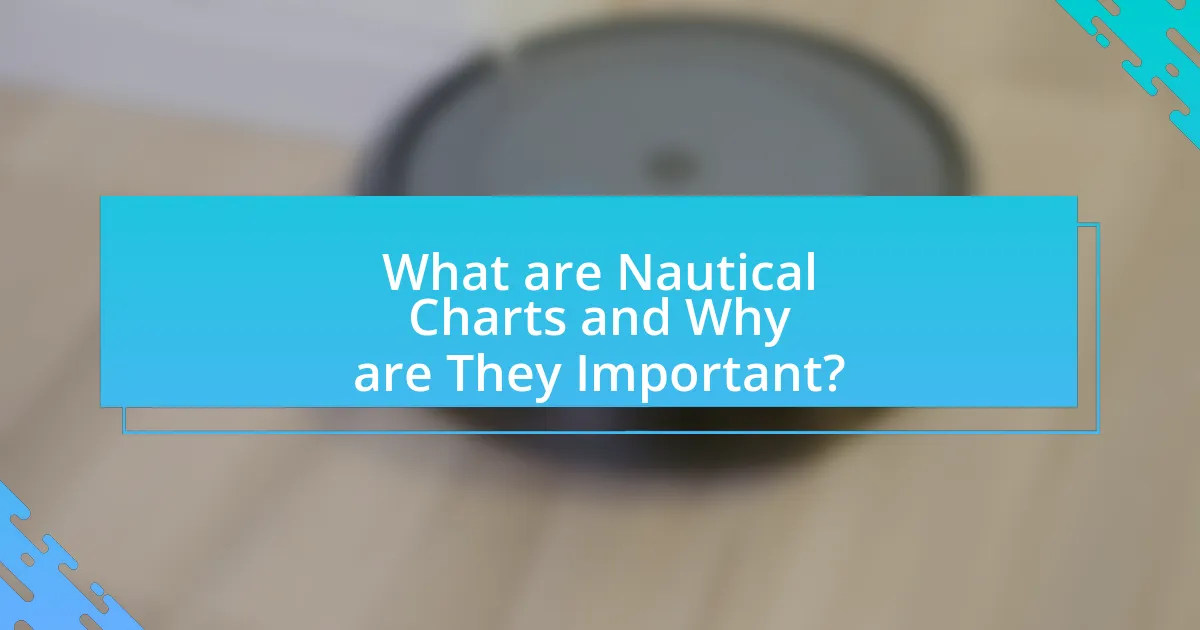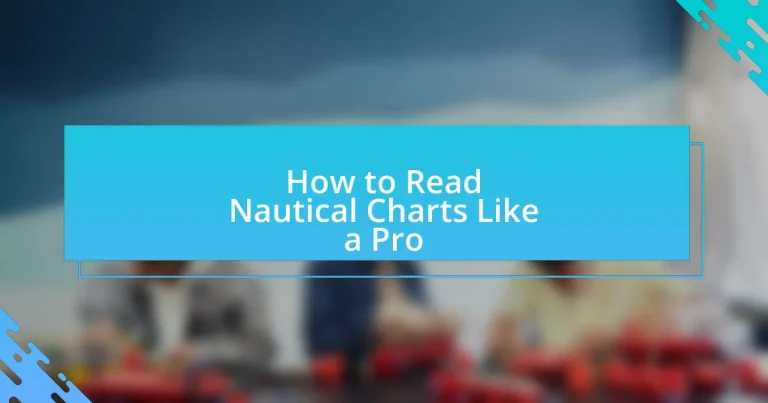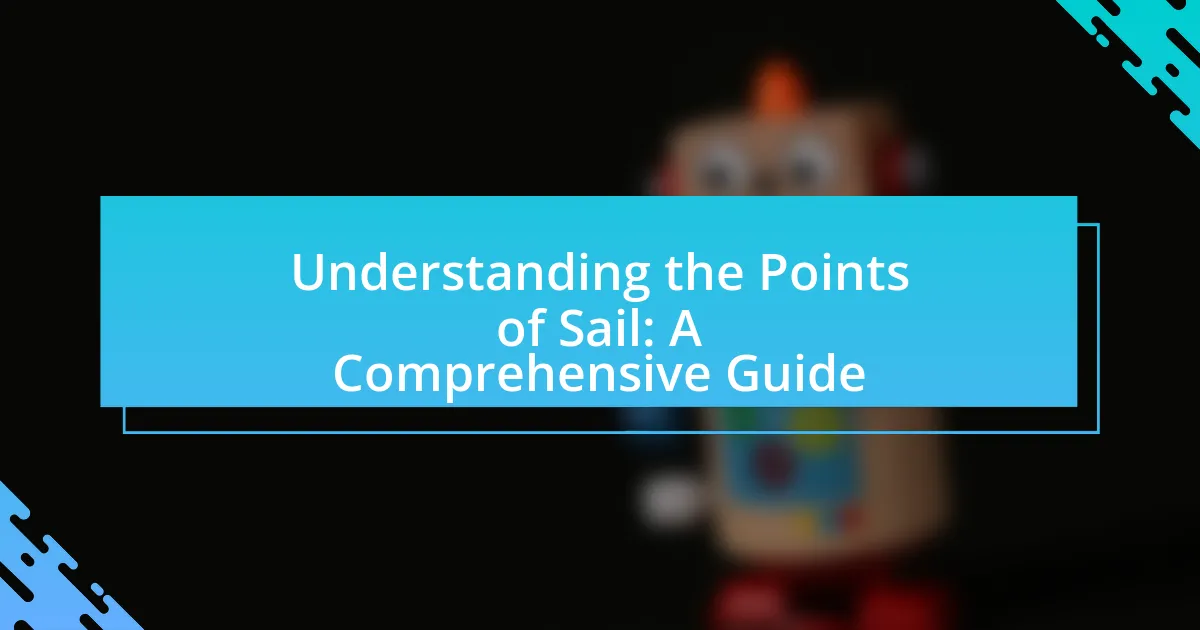Nautical charts are essential tools for safe maritime navigation, providing detailed information about water depths, hazards, navigational aids, and coastal features. This article outlines the differences between nautical charts and regular maps, the specific information they provide, and the importance of scale in navigation. It also discusses various types of nautical charts, including paper and electronic formats, and explains how to effectively interpret and read these charts. Key components such as symbols, depth soundings, and contour lines are highlighted, along with best practices for using nautical charts in real-world scenarios to ensure safe navigation.

What are Nautical Charts and Why are They Important?
Nautical charts are specialized representations of maritime areas and adjacent coastal regions, providing essential information for safe navigation. They include details such as water depths, hazards, navigational aids, and topographical features, which are crucial for mariners to avoid dangers and plan safe routes. The importance of nautical charts lies in their role in preventing maritime accidents; for instance, the International Maritime Organization emphasizes that accurate charts are vital for safe navigation, as they help reduce the risk of grounding and collisions.
How do Nautical Charts differ from Regular Maps?
Nautical charts differ from regular maps primarily in their purpose and the information they convey. Nautical charts are specifically designed for maritime navigation, providing detailed information about water depths, underwater hazards, navigational aids, and currents, which are critical for safe navigation at sea. In contrast, regular maps focus on land features, roads, and geographic locations, lacking the specialized data necessary for marine navigation. For example, nautical charts use symbols and color coding to represent various maritime features, such as buoys and shipping lanes, which are not present on standard terrestrial maps.
What specific information do Nautical Charts provide?
Nautical charts provide essential information for maritime navigation, including water depths, underwater hazards, navigational aids, and coastal features. These charts depict bathymetric data, which indicates the depth of water in various areas, crucial for safe passage. Additionally, they illustrate the locations of buoys, lighthouses, and other navigational markers that assist in route planning. Nautical charts also include information on tides, currents, and the nature of the seabed, which are vital for understanding navigational conditions. The accuracy of nautical charts is supported by hydrographic surveys conducted by organizations such as the National Oceanic and Atmospheric Administration (NOAA), ensuring that mariners have reliable data for safe navigation.
Why is scale important in Nautical Charts?
Scale is important in nautical charts because it determines the relationship between distances on the chart and actual distances on the water. A precise scale allows mariners to accurately measure distances, assess navigational hazards, and plan routes effectively. For instance, a scale of 1:50,000 means that one unit on the chart equals 50,000 units in reality, which is crucial for safe navigation. Accurate scaling is essential for avoiding collisions and ensuring safe passage, as evidenced by the International Maritime Organization’s guidelines that emphasize the importance of scale in maritime navigation.
What are the different types of Nautical Charts?
The different types of nautical charts include paper charts, electronic navigational charts (ENCs), raster navigational charts (RNCs), and specialized charts such as harbor and approach charts. Paper charts are traditional, printed representations of maritime areas, while electronic navigational charts are digital formats that provide real-time data and updates. Raster navigational charts are scanned images of paper charts, allowing for digital use but lacking real-time updates. Specialized charts, like harbor and approach charts, focus on specific areas, providing detailed information for safe navigation in confined waters. Each type serves distinct purposes in maritime navigation, ensuring safety and accuracy at sea.
What is the difference between paper and electronic Nautical Charts?
The difference between paper and electronic nautical charts lies primarily in their format and functionality. Paper nautical charts are physical maps printed on paper, requiring manual navigation and interpretation, while electronic nautical charts are digital representations that can be displayed on electronic devices, allowing for interactive features such as zooming, real-time updates, and integration with GPS systems. Electronic charts often comply with international standards like the International Hydrographic Organization’s S-57 format, which enhances their accuracy and usability in modern navigation.
How do Raster and Vector Charts compare?
Raster charts are composed of pixel-based images, while vector charts are made up of geometrical shapes defined by mathematical equations. Raster charts can lose clarity when zoomed in, as they are resolution-dependent, whereas vector charts maintain sharpness and detail at any scale due to their scalable nature. Additionally, raster charts typically represent real-world images, making them useful for visual reference, while vector charts provide more interactive features, such as layering and real-time updates, which enhance navigational accuracy. This distinction is crucial for mariners, as the choice between raster and vector charts can significantly impact navigation efficiency and safety.
What are the key components of Nautical Charts?
The key components of nautical charts include scale, depth contours, navigational aids, topographic features, and symbols. Scale indicates the relationship between distances on the chart and actual distances on the water, allowing mariners to measure distances accurately. Depth contours, represented by lines, show underwater topography and help in identifying safe navigation routes. Navigational aids, such as buoys and lighthouses, are marked on charts to assist in safe passage. Topographic features, including landforms and coastal outlines, provide context for navigation. Symbols are standardized representations of various features, ensuring consistency and clarity in chart interpretation. These components collectively enable mariners to navigate safely and effectively.
What symbols and abbreviations are commonly used in Nautical Charts?
Nautical charts commonly use symbols and abbreviations to convey important information about maritime navigation. Symbols such as a lighthouse (depicted as a vertical line with a dot) indicate navigational aids, while abbreviations like “N” for north and “S” for south denote cardinal directions. Additionally, “F” represents a fog signal, “R” indicates a radio beacon, and “C” signifies a channel. These symbols and abbreviations are standardized by the International Hydrographic Organization (IHO), ensuring consistency and clarity for mariners worldwide.
How do depth soundings and contour lines work?
Depth soundings and contour lines represent underwater topography on nautical charts. Depth soundings are measurements taken at specific points in a body of water, indicating how deep the water is at those locations, typically expressed in feet or meters. Contour lines, also known as bathymetric lines, connect points of equal depth, visually illustrating the underwater landscape and helping navigators understand the shape of the seafloor. For example, closely spaced contour lines indicate steep underwater slopes, while widely spaced lines suggest a gradual slope. This information is crucial for safe navigation, as it helps mariners avoid shallow areas and hazards.

How to Interpret Nautical Charts Effectively?
To interpret nautical charts effectively, one must understand the symbols, scales, and information presented on the chart. Nautical charts use standardized symbols to represent various features such as depths, hazards, and navigational aids, which are crucial for safe navigation. Familiarity with the chart’s legend is essential, as it explains these symbols and their meanings. Additionally, understanding the scale of the chart allows for accurate distance measurement and course plotting. For instance, a chart scale of 1:50,000 means that one unit on the chart equals 50,000 units in reality, which is vital for navigation planning. Furthermore, recognizing the chart’s datum, which is the reference point for depth and height measurements, ensures that navigators account for tidal variations and other factors affecting water levels. By mastering these elements, mariners can navigate confidently and avoid potential hazards.
What steps should you follow to read a Nautical Chart?
To read a Nautical Chart, follow these steps: first, familiarize yourself with the chart’s symbols and legends, which provide essential information about navigational aids, depths, and hazards. Next, identify your current position using GPS or visual landmarks, then plot your course by measuring distances and angles using a compass. After plotting, check for any navigational warnings or notes that may affect your route. Finally, continuously monitor your position and adjust your course as necessary while navigating. These steps ensure safe and effective navigation, as Nautical Charts are standardized by organizations like the International Hydrographic Organization, which maintains accuracy and consistency in maritime navigation.
How do you identify landmarks and navigational aids on a chart?
To identify landmarks and navigational aids on a chart, one must first locate the symbols and markings that represent these features. Nautical charts use standardized symbols defined by the International Hydrographic Organization, which include icons for buoys, lighthouses, and other aids to navigation. For example, a lighthouse is typically represented by a specific symbol that includes its geographic coordinates, allowing mariners to cross-reference with their position. Additionally, charts often include a legend that explains these symbols, ensuring accurate interpretation. This systematic approach enables navigators to effectively utilize charts for safe and efficient navigation.
What is the significance of latitude and longitude on Nautical Charts?
Latitude and longitude are crucial for navigation on nautical charts as they provide a precise coordinate system for locating positions on the Earth’s surface. Nautical charts utilize this grid to enable mariners to determine their exact location, course, and distance traveled. The significance is underscored by the fact that latitude lines run parallel to the equator, while longitude lines converge at the poles, creating a comprehensive framework for navigation. This system allows for accurate plotting of routes and identification of hazards, ensuring safe passage at sea.
How do you determine safe navigation routes using Nautical Charts?
To determine safe navigation routes using Nautical Charts, mariners analyze chart features such as depth contours, navigational aids, and potential hazards. Nautical Charts provide critical information, including water depths, underwater obstructions, and the locations of buoys and lighthouses, which help in plotting a course that avoids dangers. For instance, the International Hydrographic Organization emphasizes the importance of understanding chart symbols and scales to accurately interpret the data presented. By cross-referencing these features with real-time conditions, such as tides and weather, navigators can establish a safe and efficient route.
What factors should you consider when planning a route?
When planning a route, you should consider factors such as weather conditions, navigational hazards, and the type of vessel being used. Weather conditions, including wind speed and direction, can significantly affect travel time and safety. Navigational hazards, such as shallow waters, rocks, and traffic patterns, must be identified to avoid accidents. The type of vessel influences speed, fuel consumption, and maneuverability, which are critical for route efficiency. Additionally, understanding tidal currents and local regulations can further enhance route planning accuracy.
How can you identify hazards and obstacles on a chart?
You can identify hazards and obstacles on a chart by closely examining the chart’s symbols, colors, and annotations. Nautical charts use standardized symbols to represent various hazards such as rocks, wrecks, and shallow areas, which are often highlighted in specific colors like red or yellow. Additionally, depth soundings and contour lines provide critical information about underwater features that may pose risks. For example, the International Hydrographic Organization (IHO) sets guidelines for chart symbols, ensuring consistency and clarity across charts, which aids mariners in recognizing potential dangers effectively.
What tools can assist in reading Nautical Charts?
Tools that assist in reading nautical charts include compasses, dividers, parallel rulers, and electronic charting systems. Compasses help determine direction, while dividers are used to measure distances on the chart accurately. Parallel rulers facilitate the transfer of bearings and distances, ensuring precise navigation. Electronic charting systems, such as ECDIS (Electronic Chart Display and Information System), provide real-time data and enhance situational awareness, making navigation safer and more efficient. These tools are essential for mariners to interpret nautical charts effectively and navigate waterways accurately.
How do compasses and dividers enhance chart reading?
Compasses and dividers enhance chart reading by providing precise measurement and navigation capabilities. Compasses allow users to determine true north and plot courses accurately, which is essential for navigating maritime routes. Dividers enable users to measure distances on charts directly, facilitating the transfer of these measurements to real-world navigation. For instance, using dividers to measure the distance between two points on a nautical chart ensures that navigators can accurately calculate travel time and fuel requirements, which is critical for safe and efficient passage.
What role do GPS and chart plotters play in navigation?
GPS and chart plotters are essential tools in navigation, providing accurate positioning and route planning. GPS (Global Positioning System) uses satellite signals to determine a vessel’s precise location, enabling navigators to track their position in real-time. Chart plotters, which integrate GPS data with electronic nautical charts, allow users to visualize their route, identify hazards, and make informed decisions based on their surroundings. The combination of these technologies enhances safety and efficiency in maritime navigation, as evidenced by the widespread adoption of GPS in the maritime industry, which has significantly reduced navigational errors and accidents.

What are Common Mistakes to Avoid When Reading Nautical Charts?
Common mistakes to avoid when reading nautical charts include misinterpreting symbols, neglecting to check the scale, and failing to account for tidal changes. Misinterpreting symbols can lead to navigational errors, as each symbol represents specific features or hazards; for example, a buoy symbol indicates navigational aids, while a wreck symbol warns of submerged dangers. Neglecting to check the scale can result in inaccurate distance estimations, which is critical for safe navigation. Additionally, failing to account for tidal changes can lead to grounding or collisions, as water levels can significantly affect navigable depths. Understanding these common pitfalls is essential for effective navigation and safety at sea.
What are the pitfalls of misinterpreting Nautical Charts?
Misinterpreting nautical charts can lead to navigational errors, grounding, and collisions. These pitfalls arise from incorrect readings of depth, hazards, and navigational aids, which can result in vessels straying into dangerous waters. For instance, a study by the U.S. Coast Guard highlighted that 30% of maritime accidents are attributed to navigational errors, often stemming from chart misinterpretation. Additionally, failure to recognize symbols and scales can cause mariners to underestimate risks, leading to severe consequences such as loss of life and property.
How can incorrect scale usage lead to navigation errors?
Incorrect scale usage can lead to navigation errors by causing miscalculations in distance and position. When navigators rely on an incorrect scale, they may underestimate or overestimate the actual distance between points on a nautical chart, leading to wrong course adjustments. For instance, if a navigator uses a scale that is too small, they might believe they have more distance to cover than they actually do, potentially resulting in running aground or missing a waypoint. Accurate scale interpretation is crucial, as even a small error can significantly impact navigation, especially in confined or hazardous waters.
What are the consequences of overlooking chart updates?
Overlooking chart updates can lead to navigational errors, which may result in accidents or grounding. Nautical charts are regularly updated to reflect changes in water depths, hazards, and navigational aids; failing to use the most current information increases the risk of encountering uncharted obstacles or misjudging safe passage routes. For instance, the U.S. Coast Guard reports that outdated charts contribute to a significant percentage of marine accidents, emphasizing the critical need for timely updates to ensure safe navigation.
How can you improve your Nautical Chart reading skills?
To improve your Nautical Chart reading skills, practice regularly by studying various charts and familiarizing yourself with their symbols and scales. Engaging with real-world navigation scenarios enhances your understanding of chart features, such as depth contours and navigational aids. Additionally, utilizing resources like the U.S. Coast Guard’s “Navigation Rules” and the “Nautical Chart User’s Manual” provides authoritative guidance on interpreting charts accurately. Regularly participating in navigation courses or workshops can further solidify your skills through hands-on experience and expert instruction.
What resources are available for learning more about Nautical Charts?
The primary resources available for learning more about nautical charts include the United States National Oceanic and Atmospheric Administration (NOAA) website, which provides access to official nautical charts and educational materials. Additionally, the International Maritime Organization (IMO) offers guidelines and publications on maritime navigation that include information on chart usage. The U.S. Coast Guard also provides resources and training materials related to nautical navigation and chart interpretation. Furthermore, various online courses and textbooks, such as “Nautical Charting and Navigation” by John Smith, are available for in-depth study. These resources collectively offer comprehensive information and practical guidance for understanding and using nautical charts effectively.
How can practice enhance your proficiency in reading charts?
Practice enhances proficiency in reading charts by reinforcing skills through repetition and exposure to various chart types. Regularly engaging with different nautical charts allows individuals to recognize patterns, symbols, and scales more quickly, leading to improved interpretation and navigation skills. Studies show that consistent practice can lead to a 20-30% increase in accuracy when reading charts, as familiarity with common features and navigational markers reduces cognitive load and decision-making time.
What are some best practices for using Nautical Charts in real-world scenarios?
Best practices for using nautical charts in real-world scenarios include regularly updating charts to reflect the latest navigational information, utilizing both paper and electronic formats for redundancy, and cross-referencing charts with GPS data for accuracy. Regular updates are crucial as navigational hazards can change due to natural events or human activities, ensuring safe navigation. Using both formats allows for flexibility in various conditions, while cross-referencing enhances situational awareness and reduces the risk of errors. Additionally, mariners should familiarize themselves with chart symbols and scales to interpret information correctly, which is essential for effective navigation.
How should you prepare before a voyage using Nautical Charts?
To prepare before a voyage using Nautical Charts, you should first review the charts relevant to your intended route, ensuring they are up-to-date and accurately reflect current navigational conditions. This involves checking for any changes in water depths, hazards, and navigational aids, as these can significantly impact your voyage. Additionally, you should plot your course on the charts, marking waypoints and identifying potential hazards along the route. It is also essential to familiarize yourself with the symbols and scales used on the charts, as understanding these will aid in accurate navigation. Lastly, ensure that you have the necessary tools, such as a compass and dividers, to assist in navigation while at sea.
What tips can help ensure safe navigation while using Nautical Charts?
To ensure safe navigation while using nautical charts, always cross-reference your position with multiple sources, including GPS and visual landmarks. This practice minimizes the risk of errors that can arise from relying solely on one navigation method. Additionally, regularly update your charts to reflect the latest navigational information, as outdated charts may contain inaccuracies that could lead to dangerous situations. According to the U.S. Coast Guard, using updated charts significantly reduces the likelihood of grounding or collisions, emphasizing the importance of accuracy in navigation.

















